Masamune Shirow on Black Magic
Passages taken from Intron Depot 1 ©1991 Shirow/Seishinsha
Black Magic was a "first and a last volume" published during my fanzine years. It was published by Atlas Magazine, and put together with a lot of help from Atlas staff members. [Franco: it was published for the first time on February 1983] (Back then our workplace environment could best be described as "small and dangerous". There was no air conditioner. Every sheet of screen tone was jealously guarded). In December 1985 Seishinsha reprinted it with six additional pages (the M-66 appendix in the back). This was the book that planted Appleseed in the mind of the president of Seishinsha.
[...] This book introduced most of my favorite elements -- bioroids, armored combat robots, magic, aliens -- and they haven't changed to date (not enough R&D?).

The M-66 anti-personnel droid (also dubbed "anti-personnel automatic infantry"). This is a high performance robot, with hair that serves as a cooling unit, and a left eye equipped with a laser scalpel. [...]
Black Magic M-66 was the first original animation to involve Shirow Masamune. I was entrusted with handling the storyboards and direction, and tried to evoke the mood of a quality B-grade SF flick. So what do you think, dear readers? Anyway, it was a long, long, loonnngg row to hoe... Let me take this opportunity to express my gratitude to all who worked on the original drawings, the animation and music. You did a great job! Thanks a bunch! The laser disk somehow managed a second pressing for whatever it's called, so I guess it got Mr. Bandai's blessing. Still I was so embarrassed . I couldn't watch it for the first year and a half after it was released... It never did quite come together... But the staff really did do their best, and - aahh, enough of that. The video went on sale in the spring of 1987.
Despite its flaws, the project actually produced a finished, released work without dying on the vine-thanks to people like Mr. Bandai. Thank you! I learned an awful lot working on the project. A very few members of the staff apparently felt that I discriminate against North Korea or something - I'm not quite sure what they meant - but I want to make clear that I do no such thing. I have never engaged in petty discrimination of this sort, and I do not believe in it. Conversely, I don't intend to give special treatment to Japan either. Also, as regards violence and Eros, I don't deny that these are important elements of my manga. But I were accused of being a violence-monger or a porn-peddler, my response would be "Oh yeah? Well... it's too bad we had a breakdown in communication. Really a shame".
Black Magic Introduction
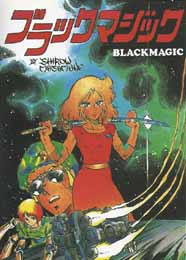 Thousand of years ago, life was present only on Venus. Here the humans built a supercomputer Nemesis. It's mission was to bring the Venusian Federation to the final Utopia. All the planet was ruled by Nemesis. But he needed someone to protect himself and to execute orders so, he created many bioroids and built for them a megalopolis. Nemesis built another computer, Tantalos, to teach the bioroids , and Uranus he's mobil terminal. The first bioroid who take the power was Chronos, but he was soon overtaken by Zeus. Than the production of bioroids was prohibited, but Nemesis built a last one, Typhon. Zeus knew this after Typhon birth and kill her. Nemesis built another Typhon but gave her to a human to protect her from Zeus, until she becomes teenager.
Thousand of years ago, life was present only on Venus. Here the humans built a supercomputer Nemesis. It's mission was to bring the Venusian Federation to the final Utopia. All the planet was ruled by Nemesis. But he needed someone to protect himself and to execute orders so, he created many bioroids and built for them a megalopolis. Nemesis built another computer, Tantalos, to teach the bioroids , and Uranus he's mobil terminal. The first bioroid who take the power was Chronos, but he was soon overtaken by Zeus. Than the production of bioroids was prohibited, but Nemesis built a last one, Typhon. Zeus knew this after Typhon birth and kill her. Nemesis built another Typhon but gave her to a human to protect her from Zeus, until she becomes teenager.
Franco: The style of this manga is very "old", worst than the first Dominion or Appleseed Book 1 and 2, but it is really interesting for every Shirow's fan. Don't forget that it has been drawn for a fanzine many years ago and this is Shirow's very first step. Here you can see how much he has improved his art through the years. I don't want to say that you have to get it absolutely: the story is confused and the drawings very simple, but there are a lot of ideas and concepts that Shirow used in his most famous works (in particular Appleseed) (take a look to Crossovers page).
Also a Japanese company has released a videogame inspired by this manga.
Masamune Shirow on the M-66 robot design and AI
Since this is a bioroid-level civilization (whatever that means!), let's suppose that biotechnology permits production of robots that otherwise would be prohibitively expensive and impossibly difficult to repair or fine-tune if made of purely mechanical parts. Since the goal is not an exact copy of a human (bioroids are for military purposes, after all), photoelectronics and limited bio-brain applications provide optimum movement and spatial perception. The result is a "killer robot." But since this robot is no more that a byproduct of the human race, and is not recognized as an independent species, Asimov's "Three Laws of Robotics" do not apply.
Take the jungles of Panama, with their 100-degree temperatures, 90 percent humidity, and torrential rains. The M-66 must be able to operate in this severe environment as well as in deserts, glaciers, swamps, water... You name it.
In short, an all-weather robot. This means there are likely to be as many different models as there are military operations. And not only humanoid, either: trees, rocks, animals are all possible variants.
The 66, considered more useful as a scout than as a combatant, can pass through booby-trapped areas, accurately and efficiently obtain information, fight if necessary, and return to base. If capture appears imminent, the 66--cognizant of the potential loss to the enemy of important intelligence--will unhesitatingly self-destruct to maximum effect... Such booby-trapping brings to mind the Vietnam War which established the reputation of booby traps as cheap, vicious weapons requiring no support. Booby traps have been employed in all shapes and sizes for wars, crimes, and acts of terrorism. There is no standard model.
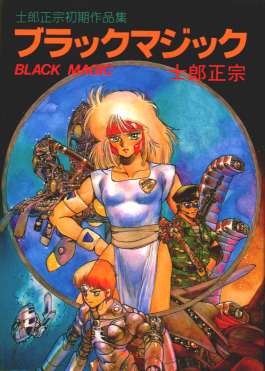 Throughout history, regardless of place or time, the first battle has always been a cruel, grisly experience for untested recruits. If green troops served among the Ottoman soldiers who stormed the Translyvania castle of Vlad Vaslav, or among the young warriors who entered the castle of Elizabeth I, they may as well have gone mad. M-66 attacks, on the other hand, are not delayed by fear: they do not waver in the face of the enemy.
Throughout history, regardless of place or time, the first battle has always been a cruel, grisly experience for untested recruits. If green troops served among the Ottoman soldiers who stormed the Translyvania castle of Vlad Vaslav, or among the young warriors who entered the castle of Elizabeth I, they may as well have gone mad. M-66 attacks, on the other hand, are not delayed by fear: they do not waver in the face of the enemy.
The 66 can endure bamboo stakes and metal spikes, and in fact, by advancing through such obstacles, can clear the way for the rear guard. One advantage to the M-66's humanoid form is that it has the same bulk, and moves in the same manner, as a human. If it were designed with four or eight legs, it could not follow routes that require human footing.
But might it not explode in an accident? If it's shot, what happens to its fuel? And what about malfunctions...? One imagines warehouses, once full of mass-produced robots, now emptied; cities crawling with the same pale feminine faces--and every one a ticking time bomb (no, no, this isn't a put-down of women!). But, of course, its power plant determines how easily an M-66 can blow up.
The model presented here is female for two reasons: to provide a lower center of gravity, and to make this manga more attractive. Besides, among humans, women have superior survival skills... not that this has anything to do with the 66. The female form also induces tension in enemy troops, making them slower to action (use of a rougher-looking character like the Hecatonchires would run the risk of intimidating even friendly troops). A make enemy meeting the 66 in the bush might be just a little less trigger happy. And a real lecher could put his own life at risk. The rubber covering of the face and skin enhances this effect, while preventing bits of shrapnel or dust from penetrating the joints. Clothing serves the same purpose.
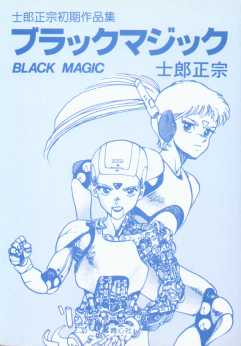 The skeleton comprises carbon fiber around a metal core. Adding strips of reinforced kevlar may improve the skeleton's resistance to attack. A standard 66 weighs between 100 and 200 kilograms, I'd guess. This could pose difficulties in swamps and quagmires, so any 66 deployed in such terrain should be equipped with rocket-propelled hook and winch--reducing its weight is not advisable as this would reduce its advantage in hand-to-hand combat. Even with new materials available to keep weight down, other factors must be considered: reactor heat, strength, center of gravity, weight distribution, the relationship of basal joint strength to peripheral weight during high-speed movement, and so on... As for dynamics--that's another complex issue we won't even try to address here.
The skeleton comprises carbon fiber around a metal core. Adding strips of reinforced kevlar may improve the skeleton's resistance to attack. A standard 66 weighs between 100 and 200 kilograms, I'd guess. This could pose difficulties in swamps and quagmires, so any 66 deployed in such terrain should be equipped with rocket-propelled hook and winch--reducing its weight is not advisable as this would reduce its advantage in hand-to-hand combat. Even with new materials available to keep weight down, other factors must be considered: reactor heat, strength, center of gravity, weight distribution, the relationship of basal joint strength to peripheral weight during high-speed movement, and so on... As for dynamics--that's another complex issue we won't even try to address here.
Bullet-proof armor is yet another concern linked inseparably to weight. Armor should be impervious to the 10 mm bullets common to infantry. The upper limit is probably +P+.45ACP, but even that would allow rifle bullets to inflict considerable damage. Maybe the best approach would be to dispense with bullet-proofing systems altogether, and instead minimize weight for improved maneuverability. That would make it easier to transport , too...
And then there's the problem of differential heating. Even with a built-in anti-condensation heater, dew may still form on lenses, filters, photoelectric parts and the like. Thus, producing all-weather models of precision machines is no easy task. No doubt, such machines are susceptible to magnetism, not to mention vibration, shock, electromagnetic pulse, torsion-induced load, etc, etc... An interesting characteristic the 66 shares with humans is that it stops moving when intake and exhaust ports (i.e., nose and mouth) are closed.
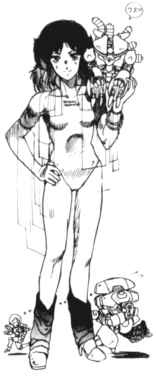 An expressionless killer (it might even be smiling) with super-human fighting power--sounds like the stuff of horror stories! Many precedents come to mind: the artificial man in Mary Woolstonecraft Shelley's Frankenstein, or--pointing up the difference between magic and science--the more modern horror of the zombie, a walking corpse.
An expressionless killer (it might even be smiling) with super-human fighting power--sounds like the stuff of horror stories! Many precedents come to mind: the artificial man in Mary Woolstonecraft Shelley's Frankenstein, or--pointing up the difference between magic and science--the more modern horror of the zombie, a walking corpse.
But a killer robot is just an extension of modern weaponry. Even if it moves on its own outside deliberate tests, it's not the work of the Devil, but simply a type of industrial accident. This is a technological (i.e., Western) sort of horror, arising precisely because living people are dragged off to their graves by a supposedly inanimate object--like a doll or a corpse--with no power or life of its own. If I had studied this type of horror story more thoroughly, I might have come up with a more interesting 66. It's something I'd like to pursue when my drawing ability has improved.
Treating the 66 as a type of weapon opens up possibilities for its use as a prop in an infinite number of scenarios; ultimately, however, the drama is a human one. In a medieval setting, the 66 could be knights pledged in fealty to a king (actually, it would more closely resemble a slave soldier, but we'll call it a knight since it's so high-priced).
This hardly bears repeating, but the artificial intelligence represented by bioroids or androids draws from the mechanical side of humanity. Nonetheless, it effuses the smell of death, which may be why some say technology is evil incarnate. If artificial intelligence is brought as close to human intelligence as possible, then perhaps the remaining difference is the fundamental essence of humanity. Thus, numerous aspects of humanity are revealed: life and death, mind and machine, the determinate and the indeterminate, etc., etc...
Sorcery and religious ritual manipulate as their technology mechanical systems within the human mind. What is left after that? How far can humans climb toward a higher order? Death in life, life in death--is that really all there is? Are we sealed up like the Eternal Golden Braid? Sleepless nights are not brought on by horror stories alone. The 66 is a "Beautiful Captive"* or the last Gauguin: "Where did we come from? Who are we? Where are we going... ?"**
To broaden the vision of the System, to become one with the Universe... these are just dreams upon dreams, not to be comprehended by a simpleton of the TV generation like myself. I'm just a monkey, my Inner Universe is made of bones. That's why I like truly barbaric, bloody, messy, noisy tumult. I want to evolve quickly into a real human being. But to be urged on by the likes of Nemesis, and evolve into some Substance X? That would lack class.
-
* Title of painting by Rene Magritte
** Title of painting by Paul Gauguin
- Black Magic M-66
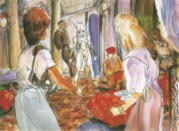
Credits
Animation Director: Takayuki Sawaura
Mechanical Animation Director: Toru Yoshida
Music: Yoshihiro Katayama
Character Design and Direction: Hiroyuki Kitakubo
Original Story, Screenplay and Direction: Masamune Shirow
|
This was the first OAV based on a Shirow's manga and his first involvement in the production of an animation. It was released in 1987 and Shirow was responsible for storyboards and direction (he tried to evoke the mood of B-grade SF movies). M is for "marionette". Runtime is 48 minutes.
 Plot: an unmarked military cargo plane goes down during a storm and two top-secret military android assassins are lost in the accident. Sybel, a freelance video journalist, gets wind of this and, in true reporter hound fashion, goes after the story.
Sybel is captured by the military, who have find the plane, but the robots attack the encampment. One is destroyed fighting against the commando team led by Col. Arthur, while the other goes on a seek and destroy mission. The target is Ferris, the granddaughter of its creator. It is a race against time as Sybel attempts to protect Ferris from the deadly machine.
Plot: an unmarked military cargo plane goes down during a storm and two top-secret military android assassins are lost in the accident. Sybel, a freelance video journalist, gets wind of this and, in true reporter hound fashion, goes after the story.
Sybel is captured by the military, who have find the plane, but the robots attack the encampment. One is destroyed fighting against the commando team led by Col. Arthur, while the other goes on a seek and destroy mission. The target is Ferris, the granddaughter of its creator. It is a race against time as Sybel attempts to protect Ferris from the deadly machine.
Above: an original production drawing by Shirow (the M-66 is in process of targeting Ferris at Lampring). On the right: the same scene from the OAV.
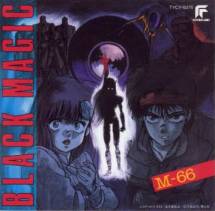 Shirow: "When I was working on the animated version of Black Magic M-66 I concentrated very intently on the techniques of Hayao Miyazaki, who was then and now still reigning over the Japanese animation industry".
Shirow: "When I was working on the animated version of Black Magic M-66 I concentrated very intently on the techniques of Hayao Miyazaki, who was then and now still reigning over the Japanese animation industry".
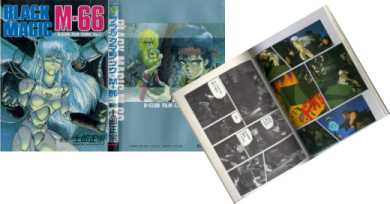 "The plan was originally to animate the "Venusian" story directly... the animation company just came knocking on my door one day with the project proposal in hand. I wasn't happy with the idea and didn't want to animate that story, so I drew up storyboards for Black Magic M-66. My beginner's curiosity lured me into becoming part of the staff; I even ended up directing it. Although the end result of the animation itself was satisfactory, my relationship with the other staff at the studio ended on a sour note, and I was reluctant to become involved in another project."
"The plan was originally to animate the "Venusian" story directly... the animation company just came knocking on my door one day with the project proposal in hand. I wasn't happy with the idea and didn't want to animate that story, so I drew up storyboards for Black Magic M-66. My beginner's curiosity lured me into becoming part of the staff; I even ended up directing it. Although the end result of the animation itself was satisfactory, my relationship with the other staff at the studio ended on a sour note, and I was reluctant to become involved in another project."
The music CD of this animation is: Black Magic M-66 - Original album (TYCY-5376). There is also a film comic by B-Club. It includes black & white and color pages.
- Black Magic M-66 Sketch Book
Thanks to Lucas Loh
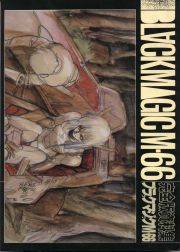 Published by: MOVIC
Published by: MOVIC
Date: 8/31/1987
Code: ISBN 4-943966-09-08 C0274
Dimensions: 181x256 mm
Price: 1000 yen
Pages: 76 (including poster)
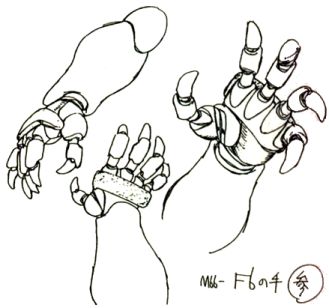 Digest Film
Digest Film
7 color pages with various screen shots from the anime with explanation text (Japanese).
Design Board (black/white section)
Many designs for the film and interpretation text, with some small story boards as part of the explanations:
18 pages of character design.
5 pages of design for the M-66 bioroids.
6 pages of design for the air military mecha.
5 pages of design for land military vehicles (tanks, jeeps, trucks,...).
7 pages of design for various equipment (guns, rifles, weapons, cameras, first aid kits, earphones, watch).
6 pages of vehicle designs: civilian vehicles (van and motorbike) followed by more air mecha designs.
15 pages of design for building interiors, structures, furniture, cities and scenarios.
1 page story layout (text and a flow chart).
Inside there is an A3 fold out poster too (color sketch by Masamune Shirow).
- The Continuity of Black Magic M-66
Thanks to Lucas Loh
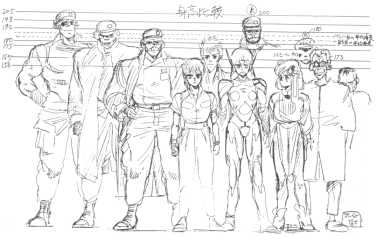
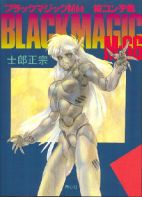 Published by: Seishinsha
Published by: Seishinsha
Date: 1986/12
Code: ISBN4-915333-30-2
Price: 1248 yen
Pages: 362
This book is much more focused on the OAV storyboards, with explanations about which is the way to create an animation. I think it contains all the storyboards used (327 pages) and they look to be made by Shirow himself. Some black and white images drawn by Shirow many years ago (good old Shirow style!) are very interesting, as the final part (32 pages) about rough designs (characters, weapons, houses,...). Unfortunately the text is Japanese only so it's impossible to understand all the explanations, the final comments and the glossary of the technical words used.





 Plot: an unmarked military cargo plane goes down during a storm and two top-secret military android assassins are lost in the accident. Sybel, a freelance video journalist, gets wind of this and, in true reporter hound fashion, goes after the story.
Sybel is captured by the military, who have find the plane, but the robots attack the encampment. One is destroyed fighting against the commando team led by Col. Arthur, while the other goes on a seek and destroy mission. The target is Ferris, the granddaughter of its creator. It is a race against time as Sybel attempts to protect Ferris from the deadly machine.
Plot: an unmarked military cargo plane goes down during a storm and two top-secret military android assassins are lost in the accident. Sybel, a freelance video journalist, gets wind of this and, in true reporter hound fashion, goes after the story.
Sybel is captured by the military, who have find the plane, but the robots attack the encampment. One is destroyed fighting against the commando team led by Col. Arthur, while the other goes on a seek and destroy mission. The target is Ferris, the granddaughter of its creator. It is a race against time as Sybel attempts to protect Ferris from the deadly machine.
 Shirow: "When I was working on the animated version of Black Magic M-66 I concentrated very intently on the techniques of Hayao Miyazaki, who was then and now still reigning over the Japanese animation industry".
Shirow: "When I was working on the animated version of Black Magic M-66 I concentrated very intently on the techniques of Hayao Miyazaki, who was then and now still reigning over the Japanese animation industry".
 "The plan was originally to animate the "Venusian" story directly... the animation company just came knocking on my door one day with the project proposal in hand. I wasn't happy with the idea and didn't want to animate that story, so I drew up storyboards for Black Magic M-66. My beginner's curiosity lured me into becoming part of the staff; I even ended up directing it. Although the end result of the animation itself was satisfactory, my relationship with the other staff at the studio ended on a sour note, and I was reluctant to become involved in another project."
"The plan was originally to animate the "Venusian" story directly... the animation company just came knocking on my door one day with the project proposal in hand. I wasn't happy with the idea and didn't want to animate that story, so I drew up storyboards for Black Magic M-66. My beginner's curiosity lured me into becoming part of the staff; I even ended up directing it. Although the end result of the animation itself was satisfactory, my relationship with the other staff at the studio ended on a sour note, and I was reluctant to become involved in another project."
 Published by: MOVIC
Published by: MOVIC
 Digest Film
Digest Film

 Published by: Seishinsha
Published by: Seishinsha



 Thousand of years ago, life was present only on Venus. Here the humans built a supercomputer Nemesis. It's mission was to bring the Venusian Federation to the final Utopia. All the planet was ruled by Nemesis. But he needed someone to protect himself and to execute orders so, he created many bioroids and built for them a megalopolis. Nemesis built another computer, Tantalos, to teach the bioroids , and Uranus he's mobil terminal. The first bioroid who take the power was Chronos, but he was soon overtaken by Zeus. Than the production of bioroids was prohibited, but Nemesis built a last one, Typhon. Zeus knew this after Typhon birth and kill her. Nemesis built another Typhon but gave her to a human to protect her from Zeus, until she becomes teenager.
Thousand of years ago, life was present only on Venus. Here the humans built a supercomputer Nemesis. It's mission was to bring the Venusian Federation to the final Utopia. All the planet was ruled by Nemesis. But he needed someone to protect himself and to execute orders so, he created many bioroids and built for them a megalopolis. Nemesis built another computer, Tantalos, to teach the bioroids , and Uranus he's mobil terminal. The first bioroid who take the power was Chronos, but he was soon overtaken by Zeus. Than the production of bioroids was prohibited, but Nemesis built a last one, Typhon. Zeus knew this after Typhon birth and kill her. Nemesis built another Typhon but gave her to a human to protect her from Zeus, until she becomes teenager.
 Throughout history, regardless of place or time, the first battle has always been a cruel, grisly experience for untested recruits. If green troops served among the Ottoman soldiers who stormed the Translyvania castle of Vlad Vaslav, or among the young warriors who entered the castle of Elizabeth I, they may as well have gone mad. M-66 attacks, on the other hand, are not delayed by fear: they do not waver in the face of the enemy.
Throughout history, regardless of place or time, the first battle has always been a cruel, grisly experience for untested recruits. If green troops served among the Ottoman soldiers who stormed the Translyvania castle of Vlad Vaslav, or among the young warriors who entered the castle of Elizabeth I, they may as well have gone mad. M-66 attacks, on the other hand, are not delayed by fear: they do not waver in the face of the enemy.
 The skeleton comprises carbon fiber around a metal core. Adding strips of reinforced kevlar may improve the skeleton's resistance to attack. A standard 66 weighs between 100 and 200 kilograms, I'd guess. This could pose difficulties in swamps and quagmires, so any 66 deployed in such terrain should be equipped with rocket-propelled hook and winch--reducing its weight is not advisable as this would reduce its advantage in hand-to-hand combat. Even with new materials available to keep weight down, other factors must be considered: reactor heat, strength, center of gravity, weight distribution, the relationship of basal joint strength to peripheral weight during high-speed movement, and so on... As for dynamics--that's another complex issue we won't even try to address here.
The skeleton comprises carbon fiber around a metal core. Adding strips of reinforced kevlar may improve the skeleton's resistance to attack. A standard 66 weighs between 100 and 200 kilograms, I'd guess. This could pose difficulties in swamps and quagmires, so any 66 deployed in such terrain should be equipped with rocket-propelled hook and winch--reducing its weight is not advisable as this would reduce its advantage in hand-to-hand combat. Even with new materials available to keep weight down, other factors must be considered: reactor heat, strength, center of gravity, weight distribution, the relationship of basal joint strength to peripheral weight during high-speed movement, and so on... As for dynamics--that's another complex issue we won't even try to address here.
 An expressionless killer (it might even be smiling) with super-human fighting power--sounds like the stuff of horror stories! Many precedents come to mind: the artificial man in Mary Woolstonecraft Shelley's Frankenstein, or--pointing up the difference between magic and science--the more modern horror of the zombie, a walking corpse.
An expressionless killer (it might even be smiling) with super-human fighting power--sounds like the stuff of horror stories! Many precedents come to mind: the artificial man in Mary Woolstonecraft Shelley's Frankenstein, or--pointing up the difference between magic and science--the more modern horror of the zombie, a walking corpse.